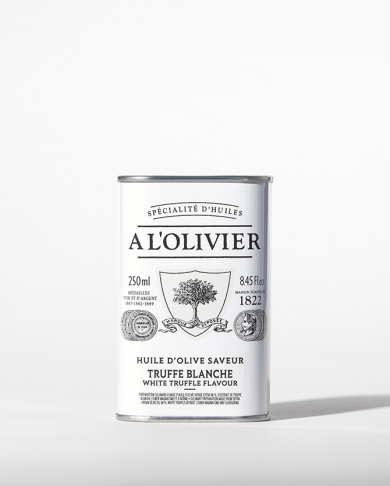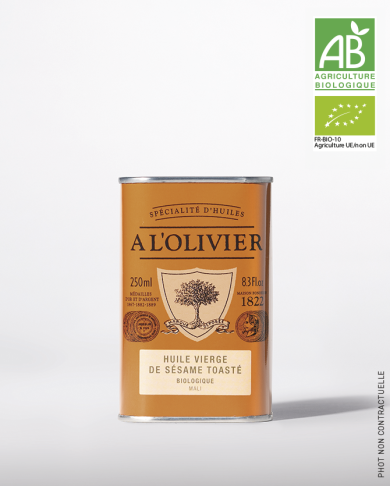INSPIRATIONS


Expert advice
| 23.12.2021
Vegetable oils: the guide to cooking oils

Of all the fats used in cooking, oils occupy a special place! Thanks to the wide variety of flavours (olive, rapeseed, sesame, nuts, flaxseed, hemp, grapeseed…), they’re essential for seasoning our favourite recipes. Some can withstand high temperatures and can be used for cooking. Rich in essential fatty acids (omega 3, omega 6 and omega 9), they contribute to a healthy diet. Take a look at our guide to vegetable oils below!
The most commonly used oils in the kitchen
When it comes to cooking, oils are classified into two categories: those that can be used for cooking and those that are best consumed cold as a dressing or garnish. In addition to extra virgin olive oil (which can be used for seasoning or cooking) and rapeseed oil (best consumed cold), there are also a lot of advantages to using sunflower oil, whether plain or infused. Widely used in professional kitchens since it doesn’t solidify in cold temperatures, grapeseed oil, with its neutral flavour, is most commonly used to make mayonnaise. Let’s take a look at the three most popular oils.
Extra virgin olive oil
Extra virgin olive oil, considered to be the best olive oil, must be free of any organoleptic defects. Its oleic acid level must be less than 0,8%, while this can rise up to 2% for virgin olive oil. The latter may have very slight taste defects depending on the regulations. In any case, cold pressing is intrinsic to the manufacture of olive oil in modern mills that use continuous and centrifugal processes. The term “first cold pressed” refers to a bygone era when olive press mills, which had equipment less powerful than today’s, carried out a second pressing with hot water. Cold-pressed olives retain all their nutritional benefits. Another advantage of olive oil is that it can be used both cold and hot, as it handles higher temperatures without breaking down. As is the case for all oils, just be careful not to let it smoke. For dressings and garnishing, choose a refined extra virgin olive oil like our PDO Baux-de-Provence valley oil or PDO Corsica oil. For cooking, a good everyday oil is what you need, for example our vintage olive oil from Spain. Measure out your olive oil with a tablespoon to make sure you use the right amount.
Rapeseed oil
Virgin rapeseed oil is rich in vitamins and monounsaturated (omega 9) and polyunsaturated (omega 3 and 6) fatty acids as well as vitamin E. It must be used cold, for dressings and seasonings. Do not heat rapeseed oil to preserve its nutritional properties.
Sunflower oil
We should really be talking about sunflower oils in the plural since there’s such a diversity. This is one of the most consumed oils in France. On the one hand, you have linoleic sunflower oil, which is packed with omega 6. On the other, you have oleic sunflower oil, which contains more omega 9. While linoleic sunflower oil should only be consumed cold as a seasoning or dressing, oleic sunflower oil is heat resistant and can be used in cooking. It’s much more neutral in flavour than olive oil and makes a good base for capturing the flavours of fresh herbs and spices which don’t pair so well with olive oil. That’s why we’ve chosen to infuse Thai basil, curry and smoked chipotle pepper in sunflower oil: use it in salads to switch things up, or as a garnish on stir-fried rice or curry.
Nut and seed oils
Among the oleaginous plants (i.e., those that produce oil), nuts (walnuts, hazelnuts, almonds, cashews, pistachios, pecans…) and seeds (sesame, flax, pumpkin, hemp, chia…) account for a large percentage of production. To make sure they keep well, it’s best to get into the habit of storing opened bottles in the fridge to prevent them going stale.
Sesame seed oil
High in vitamins E and K1, sesame seed oil is rich in monounsaturated and saturated fatty acids as well as antioxidants. It can be made from raw sesame seeds, which have a sweeter flavour, or from lightly toasted sesame seeds, which have a stronger taste similar to that of hazelnut. At A L’Olivier, we’ve chosen toasted sesame seeds, cold pressed to preserve its delicate flavour. Particularly popular in Asian cuisines, sesame seed oil is used in small quantities in ginger dressings, chicken marinades with soy sauce, and as a garnish on sautéed noodles with pak choi cabbage.
Pistachio oil
In ancient times, the Greeks believed that pistachios had pain-relieving properties, and used their oil on wounds and burns to help heal and prevent infection. Nowadays, pistachio oil is enjoyed for its delicate sweetness, both in savoury and sweet dishes. It balances out the bitterness of foie gras, gizzards and poultry liver. Combined with a bit of sherry vinegar, pistachio oil also makes a delicious dressing for lamb’s lettuce salad. In desserts, pistachio oil really brings out almond flavours in French financiers or Galette des rois (a traditional French cake). It also tastes delicious with chocolate.
Walnut and hazelnut oil
Walnut and hazelnut oils contain Omega-3. Walnut oil, with its deliciously rich taste, tastes great with an endive or Treviso lettuce salad. Lentils (either cold in a salad or hot) taste even better with a dash of walnut oil and a few drops of sherry vinegar. It also works well in desserts, enhancing the flavours of walnut cake and adding extra flavour to pralines. Hazelnut oil has a more delicate flavour. A l’Olivier’s carefully prepared hazelnut oil has the intense yet subtle flavour of toasted hazelnuts. It’s delicious drizzled over a fresh cheese sandwich or a lamb’s lettuce salad, or even a curly endive salad with bacon lardons. Hazelnut and chocolate is a classic flavour combination, so hazelnut oil is guaranteed to add a delicious flavour to chocolate spreads, chocolate cake or hazelnut and chocolate ice cream.
What about infused aromatic oils?
Aromatic oils infused with herbs and spices are a kitchen essential, allowing you to add the delicious flavour of aromatic plants to your recipes: thyme, rosemary, basil… as well as spices like chillies and curry. Other plants are also well-suited to this natural infusion process (which the team at A l’Olivier are specialists in), such as the lemon, whose flavour works well with olive oil. Aromatic black truffle flavour olive oil or aromatic white truffle flavour olive oil are bursting with the authentic flavours of these opulent mushrooms so you can enjoy them throughout the year, not just on special occasions. To make the most of the delicious flavour of these infused aromatic oils, use them cold. They make a delicious gift for yourself or a loved one!
Want a little tip? : regularly change your cooking oils and seasoning oils to vary your nutritional intake. Another good tip: mix two types of nutritional oil together within one dressing (rapeseed+olive oil, plain or infused, sesame seed+olive oil, walnut+olive oil…) to get all their benefits in one bite.

 Menu
Menu
 Mon compte
Mon compte  Wishlist
Wishlist  Panier
Panier 


